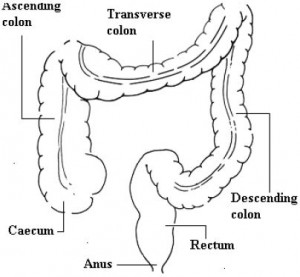What is the colon?
The colon refers to the large intestine or bowel. It forms the lowest part of the digestive system after the small bowel and it ends with the rectum and the anus.
What happens during the operation?
 Your operation will be done by either an ‘open’ operation where one long incision (cut) will be made in your abdomen (tummy) or keyhole surgery using a few small incisions.
Your operation will be done by either an ‘open’ operation where one long incision (cut) will be made in your abdomen (tummy) or keyhole surgery using a few small incisions.
After removing the portion of the colon, the surgeon will join the two healthy ends together using either a series of sutures (stitches) or staples. This is called an anastomosis. Whether you have open or keyhole surgery will depend on many things. Each case has to be looked at individually so you will need to discuss your options with your surgeon and find out which way of operating is best for you.
Keyhole surgery
Your surgeon will make three or four small (one centimetre) cuts in your abdomen. They will put a telescope camera into one of these small cuts to show an enlarged image (on a television screen) of the organs in your abdomen. The other cuts allow the surgeon to use special operating instruments. Your surgeon will make one of the cuts longer (8 to 10 cms) so they can remove the bowel portion they have operated on. Sometimes it is not possible or safe to finish the operation by laparoscopic surgery. If so, your surgeon will change to an ‘open’ operation and make a larger incision to deal with this. Many surgeons are now using a robot to help with keyhole operation including right hemicolectomy.
Will I need any special preparation before surgery?
You will have investigations and tests to prepare you for your operation. These are to confirm the diagnosis, to see how far the disease has spread, and to assess how fit and well you are for the proposed treatment.
Will I need to have a stoma (bowel bag)?
It is very unlikely that you will need a stoma. However, sometimes it is not possible to join the bowel back together again, so the end of the bowel is brought out onto the abdomen (tummy) to form an opening outside the body, known as a stoma. A stoma bag is then fitted around this opening to collect your bowel contents.
The stoma may be permanent or temporary.
If you need a stoma or it is possible that you may need a stoma, you will be seen by a stoma nurse. These specialist nurses are skilled in caring for patients who have a stoma and will be able to answer any questions you may have.
Are there complications with this operation?
Risks of this operation are small and much less likely to affect you than the risk of doing nothing. However, this is a major operation and some people (less than 5% or fewer than 1 in 20) do not survive the surgery.
There are sometimes complications. These may include:
- Bleeding
- Infection
- A leak from the anastomosis (the join where the bowel is connected back together)
- Injury to other organs within the abdomen (for example, the small intestine, ureter, or bladder)
- Deep vein thrombosis (blood clots in the veins in the legs), or
- Pulmonary emboli (blood clots in the lungs)
What should I expect after surgery?
Immediately after the operation (within the first 24 to 48 hours), you will need:
- Oxygen through a face mask
- A drip into a vein in one of your arms to give you fluid
- A catheter (tube) in your bladder to drain away urine, and
- Medication to deal with pain from the incision. This may be given as an epidural (where the medicine is given through a fine tube in your back) or through the drip
Later (the following day or so), you will need to:
- Start eating again, starting with liquids and gradually introducing solid foods, and
- Move around as soon as possible
If you have laparoscopic or robotic surgery, you may recover more quickly after surgery and go home sooner.
When you first start going to the toilet again, your faeces will be liquid. Sometimes it takes several weeks to get back to normal, and occasionally you may have to adjust your diet.
How long will I need to be in hospital?
You will stay in hospital for as little time as necessary, usually for between three and seven days. Your surgeon or specialist nurse will discuss with you daily achievements which you should try to meet. This programme is called ‘Enhanced Recovery After Surgery’ (ERAS).
If, after you leave hospital, you have any new concerns or problems (for example, severe abdominal pain, a raised temperature or bleeding) it is important to contact your own doctor (GP) or the hospital. You will be given contact numbers when you leave hospital.